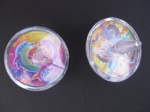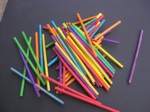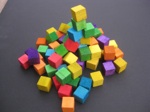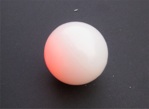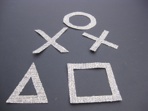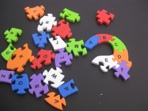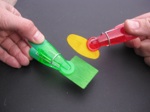Fine Motor Toolkit



Fine Motor Toolkit
You will find everything you need inside this box to complete these activities. Please feel free to supplement with standard materials, such as paper or extra paper.
The tweezers and stencils are in the metal box.
The lilypad(s) are under the whiteboard.
There is only one pen for the whiteboard, and it is marked.
Although only the puzzle game called for a die, the dice and the timer can be incorporated to add challenge or competition to almost any activity.
Please be careful with sharp objects, such as children’s scissor in box.
Enjoy.
Diane Makovsky, OTS
Bay Path College
__________________________________________________________________________________
Spinning Tops
•Spin one top
•Spin a top within a space (defined by a holes in geometric instruments)
•Two-handed spin, spin two tops one with each hand, try to do the spin simultaneously
•Spin a number of tops, two, three, or four. Try to get them all spinning at one time.
Skills
Simple rotation
Complex rotation
Arch development
Bilateral integration
__________________________________________________________________________________
Sticks (Alter grasp for any of these games. For instance, pick up sticks between thumb and first finger, then thumb and first and second fingers, then thumb and third finger only, and so on. Can be played lying on stomach on floor, seated at tables, sitting on floor, even standing)
1.Put sticks in bottle
2.Pick-up sticks (with or without moving others)
3.Create a shape with sticks (triangle, squares)
4.Construct a tower (start with a square, cross-hatch structure, two in one direction, two in the other); try other shaped towers; try using only one color per level, or use colors in a sequence, one stick in yellow, orange, purple, blue, and so on
5.Construct a pile of sticks as high as you can
6.Stick finger twirling, end over end
7.Stick finger twirling, between fingers from thumb and index finger and twirl down to fourth finger and pinkie; twirl back
-
8.Use sticks to draw in play-dough, pictures, letters, numbers, names
Skills
Grasps—Finger, pincer, tripod, precision
Isolated finger movement
Arch development—some games can be done even before prehensile grasp development
Reach
Organization
Problem-solving
Self-regulation, coping, and attending to task
Visual, spatial relations
__________________________________________________________________________________
Frogs
1.Frog racing
a.First learn to move the frog
b.Next try to move the frog toward any target or distance
c.Try a variety of races—furthest in one go; race across a room.
d.Then practice with a particular finger or combination of fingers; then try with other hand; use both hands and move more than one frog at a time.
2.Get frog home to his on lilypad. Work with one frog and control the jumps until he reaches his lilypad pad.
Skills
Isolated finger movement
Strength
Tone
Endurance
Visual motor integration
__________________________________________________________________________________
Blocks
Pour the blocks out of container and:
1.Pick up blocks one at a time while holding the previous ones in hand until you cannot hold any more
2.Drop the blocks, one at a time, back into the pile, or any of the other containers in kit.
3.Repeat exercise but this time pick up blocks using both hands at the same time. (Try picking up the same color blocks at the same time.)
4.Make a flat picture, like a mosaic, with the blocks
5.Build something with the blocks (such as a tower, or a bridge, or a boat)
Skills
In hand manipulation
Power grasp
Finger to palm translation
Palm to finger translation
Arch development
Bilateral integration
Fine motor integration
__________________________________________________________________________________
Pom-poms (and Fan)
1.Pick up and sort pom-poms from a pile.
a.Use tweezers and/or tongs, and alternate hold, using pincer, tripod, even power grasp (tweezers are in metal box)
b.Sort by color into piles or put into tray holder (used earlier with blocks)
2.Flick a pom-poms toward a target (extremely fun to make this a race)
a.Change this game by using the fan to control the pom-pom. Make sure to practice opening and closing the fan with two hands, and then one hand.
Skills
Isolated finger movement
Grasps—pincer, tripod, power
Shift
__________________________________________________________________________________
Bouncy Light Ball (and others balls, included for size variation)
A variety of ball games can be played where the control and degree of dexterity needed can be changed by distances. Begin by just bouncing the ball a few inches and work up.
1.Bounce and catch with one hand
2.Bounce the ball with one hand and catch with other
3.Bounce the ball between the two of you, and add to the fun by adding one or both of the other balls.
4.If in a suitable place, bouncing and catching the ball off an outside wall
5.Also, a makeshift game of jacks can be createed by using the pom-poms, blocks, frogs, or any other object in the kit.
Skills
Power grasp
Spherical grasp
Hand arches
Visual-spatial perception
__________________________________________________________________________________
Sandpaper Figures (and sand)
These figures (vertical line, horizontal line, circle, cross, right oblique, square, left oblique, oblique cross, and triangle) are essential shapes used in handwriting, so it is good for children to become used to the shapes.
1.Trace the shapes on the sandy side with fingers
2.Turn over the shapes and trace the shapes
3.Now draw the shape with one line within the traced shape
4.Try drawing the shapes freehand (either as line figures or as bubble shapes)
5.Hold up the shapes and call out the names (paying particular attention to the left/right obliques)
6.Put a shape, or shapes, down on paper and sprinkle sand around it then pick up to see pattern shape in the sand.
Skills
Isolated finger movements
Grasp—varied depending on current development
Shift
__________________________________________________________________________________
Alphabet Puzzle
1.Pick up and sort pieces by color
2.Now sort and arrange in alphabetical order
3.Put together the puzzle, placing the letters together in alphabetical order
a.What is it?
4.Alphabet puzzle game
a.Mix the pieces up
b.Roll one die
c.Select, sight unseen, that number of pieces from the bag
d.Assemble what you can
e.Next person takes a turn and does same
f.When all the pieces are gone, the person with the most letters assembled wins (unattached pieces do not count)
Skills
Grasp
In hand manipulation
Simple and complex rotation
Isolated finger movement
Reach
Organization
Problem solving
__________________________________________________________________________________
Glass Beads and Play-Doh
1.Grab a handful of glass beads and put them through the slot in the opening of the container.
2.Mix the beads in Play-Doh and retrieve them. Instruct to retrieve them in a variety of ways, such as between thumb and index finger, thumb and next two fingers (tri-pod grasp).
3.Use the opposite hand to do each of the first two activities.
4.Do each of the first two activities with two hands, in an alternating pattern, first put a bead through the slot with left hand, then right, continuing to hold extra beads in hands.
5.When beads are out of play-doh, make some little doh balls for fun, or really make something. Use both hands.
Try counting aloud during the activities.
Skills
Muscle tone of the intrinsic muscles of the hand
Pincer grasp
Tripod grasp
Precision grasp
Arch development
Bilateral integration
__________________________________________________________________________________
Deck of Cards
1.Turn over cards as fast as you can (do this all together, or divide the pack and race)
2.Sort cards into categories (suits, colors, numbered pairs or foursomes), again it can be done at speed
3.Flip cards into a container (even the toolkit box)
4.Learn to shuffle cards, and maybe deal the deck for a game of Go Fish
Skills
Grasps—pincer, tri-pod, potentially disk
Arch development
In hand manipulation
Potential for rotation, depending on how card turning is completed
Memory retrieval
Organization
__________________________________________________________________________________
Tennis Gobbler
1.Begin with a number of items in the Gobbler’s mouth. Reach inside and identify one item and bring it out. Continue until Gobbler is empty.
2.Now it is time for Gobbler to pick things up. Either pick up the items just emptied, or find some new ones. Fill Gobbler up by squeezing the ball.
Skills
Spherical grasp
Arch development
Other grasps can be used, depending on instruction to take out items
Strength and endurance
Stereognosis
__________________________________________________________________________________
Necklaces and Mini Ring Toss
1.Put the pieces together to make a necklace or bracelet.
2.Use the pieces for a table-top ring toss, or place the items over the blue, orange, yellow, red plastic guides. (Double-sided tape included).
3.Have fun tracing around the pieces, both plastic guides and jewelry pieces. See what kind of design you can make.
Skills
Grasp--disk, pincer, tri-pod
Shift and/or in hand manipulation
Visual motor/eye-hand coordination
__________________________________________________________________________________
Magnetic Letters and Numbers
1.Trace the letters (or numbers)
a.On paper or whiteboard
2.Trace the letter and have child color in the shape
3.Make a word and stick the letters on the magnetic plate or box
4.Remove the letters from plate, while saying what the letter it is
5.Select letters to spell word, trace the letters to write a word
6.Identify the letters and numbers
Skills
Grasp—dependent on level of development, moving toward a tri-pod grasp
Isolated finger movement
Finger strength
__________________________________________________________________________________
Shapes, Coloring, and Cutting
Use crayons or markers to:
1.Trace the shape, or combine shapes to create a design, but keep in mind the next step will be to cut out the shape.
2.Color one of the pages included, or draw your own picture. Remember the next step will be to cut it out.
Skills
Scissor grasp
Grasp used for holding crayon, tri-pod or other
Strength
__________________________________________________________________________________
Wikki Sticks
1.Enjoy the tactile feel by making a picture and placing wiki sticks on paper
2.Shape the sticks into letters, and then words
3.Make shapes (animals, flower)
4.Outline a character in a book
Skills
Individual finger control
Hand arches
Strength
Problem solving
Language
__________________________________________________________________________________
Colorful Crocodiles
1.Go around the room and attach the six crocodiles (clips) to things and have your crocodile hunter go round them up.
2.Have a crocodile conversation, either between two crocodiles (one per person), or even more by having one person control two crocodiles, one in each hand.
3.Crocodiles like to hunt or snap for meals. Sprinkle the colorful elastic bands in the swamp and let the crocodiles feast.
Skills
Pincer or tri-pod grasp
Hand arches
Strength
Problem solving
Language
Other Combinations
Feel free to mix and match items in the box.
Try using the numbers to count frogs
Drop some beads in the sand and fish them out
Use some play-doh to anchor the sticks together for your towers
__________________________________________________________________________________
